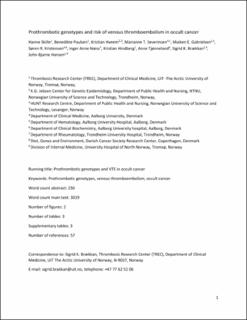| dc.contributor.author | Skille, Hanne | |
| dc.contributor.author | Paulsen, Benedikte | |
| dc.contributor.author | Hveem, Kristian | |
| dc.contributor.author | Severinsen, Marianne T. | |
| dc.contributor.author | Gabrielsen, Maiken Elvestad | |
| dc.contributor.author | Kristensen, Søren R. | |
| dc.contributor.author | Næss, Inger Anne | |
| dc.contributor.author | Hindberg, Kristian | |
| dc.contributor.author | Tjønneland, Anne | |
| dc.contributor.author | Brækkan, Sigrid Kufaas | |
| dc.contributor.author | Hansen, John-Bjarne | |
| dc.date.accessioned | 2022-10-24T07:36:14Z | |
| dc.date.available | 2022-10-24T07:36:14Z | |
| dc.date.created | 2021-08-06T15:10:51Z | |
| dc.date.issued | 2021 | |
| dc.identifier.citation | Thrombosis Research. 2021, 205 17-23. | en_US |
| dc.identifier.issn | 0049-3848 | |
| dc.identifier.uri | https://hdl.handle.net/11250/3027754 | |
| dc.description.abstract | Background
Studies have reported that the combination of some prothrombotic genotypes and overt cancer yields a synergistic effect on VTE risk. Whether individual prothrombotic genotypes or number of risk alleles in a genetic risk score (GRS) affect VTE risk in occult cancer have not been addressed. The aim of this study was to investigate the joint effect of five prothrombotic genotypes and occult cancer on VTE risk.
Methods
Cases with incident VTE (n = 1566) and a subcohort (n = 14,537) were sampled from the Scandinavian Thrombosis and Cancer Cohort (1993–2012). Five single nucleotide polymorphisms previously reported in a GRS were genotyped: ABO (rs8176719), F5 (rs6025), F2 (rs1799963), FGG (rs2066865) and F11 (rs2036914). Hazard ratios (HRs) for VTE by individual SNPs and GRS were estimated according to non-cancer and occult cancer (one year preceding a cancer diagnosis) exposure.
Results
Occult cancer occurred in 1817 subjects, and of these, 93 experienced a VTE. The VTE risk was 4-fold higher (HR 4.05, 95% CI 3.28–5.00) in subjects with occult cancer compared with those without cancer. Among subjects with occult cancer, those with VTE had a higher proportion of prothrombotic and advanced cancers than those without VTE. The VTE risk increased according to individual prothrombotic genotypes and GRS in cancer-free subjects, while no such effect was observed in subjects with occult cancer (HR for ≥4 versus ≤1 risk alleles in GRS: 1.14, 95% CI 0.61–2.11).
Conclusions
Five well-established prothrombotic genotypes, individually or combined, were not associated with increased risk of VTE in individuals with occult cancer. | en_US |
| dc.language.iso | eng | en_US |
| dc.publisher | Elsevier | en_US |
| dc.rights | Attribution-NonCommercial-NoDerivatives 4.0 Internasjonal | * |
| dc.rights.uri | http://creativecommons.org/licenses/by-nc-nd/4.0/deed.no | * |
| dc.title | Prothrombotic genotypes and risk of venous thromboembolism in occult cancer | en_US |
| dc.type | Peer reviewed | en_US |
| dc.type | Journal article | en_US |
| dc.description.version | acceptedVersion | en_US |
| dc.rights.holder | This is the authors' accepted manuscript to an article published by Elsevier. | en_US |
| dc.source.pagenumber | 17-23 | en_US |
| dc.source.volume | 205 | en_US |
| dc.source.journal | Thrombosis Research | en_US |
| dc.identifier.doi | 10.1016/j.thromres.2021.06.019 | |
| dc.identifier.cristin | 1924444 | |
| cristin.ispublished | true | |
| cristin.fulltext | postprint | |
| cristin.qualitycode | 1 | |

